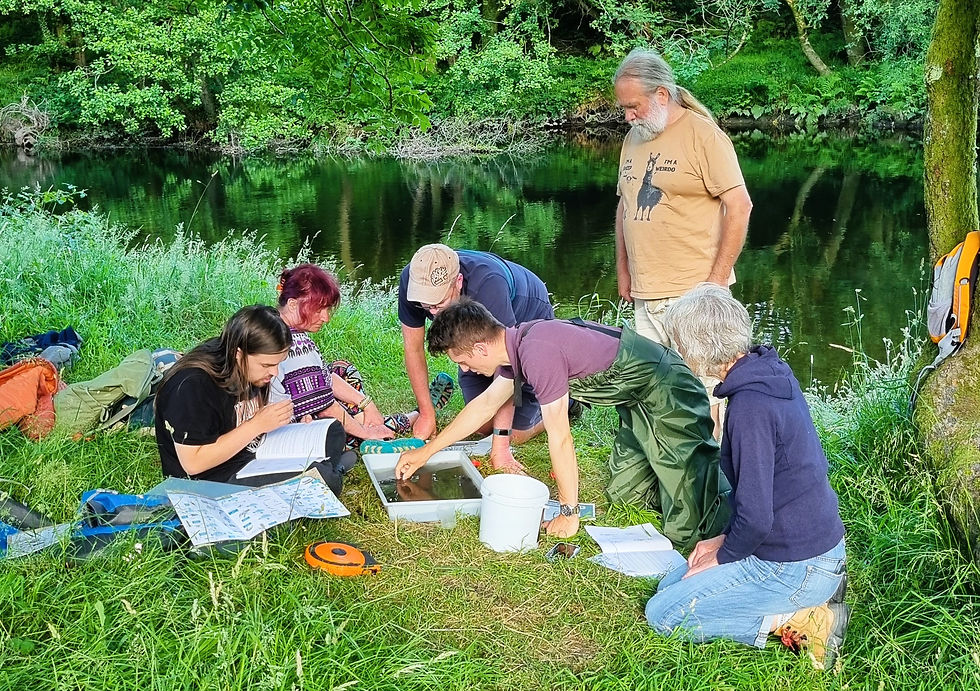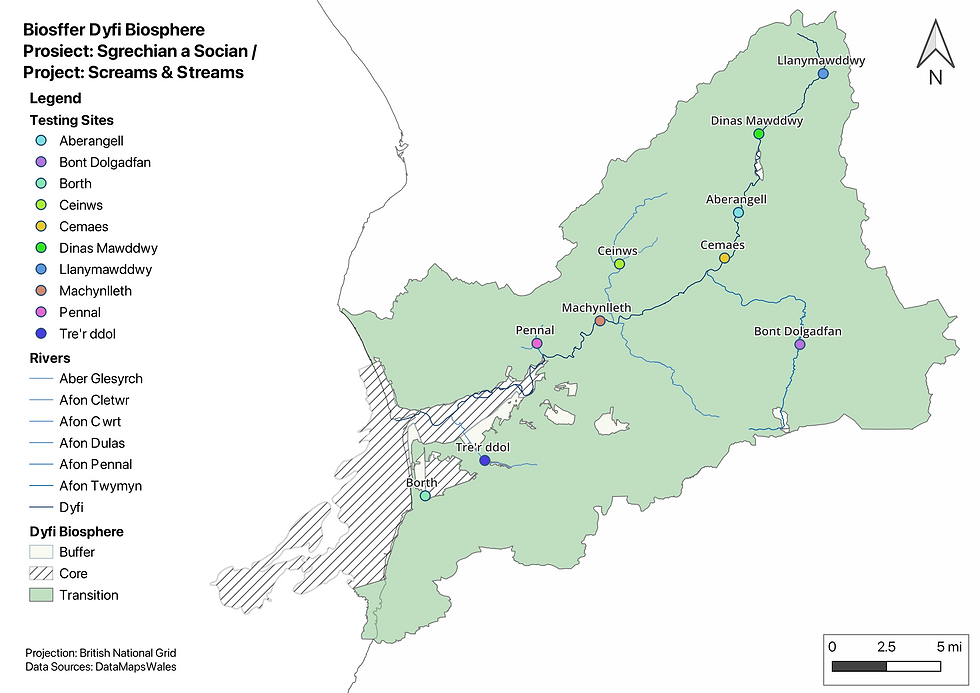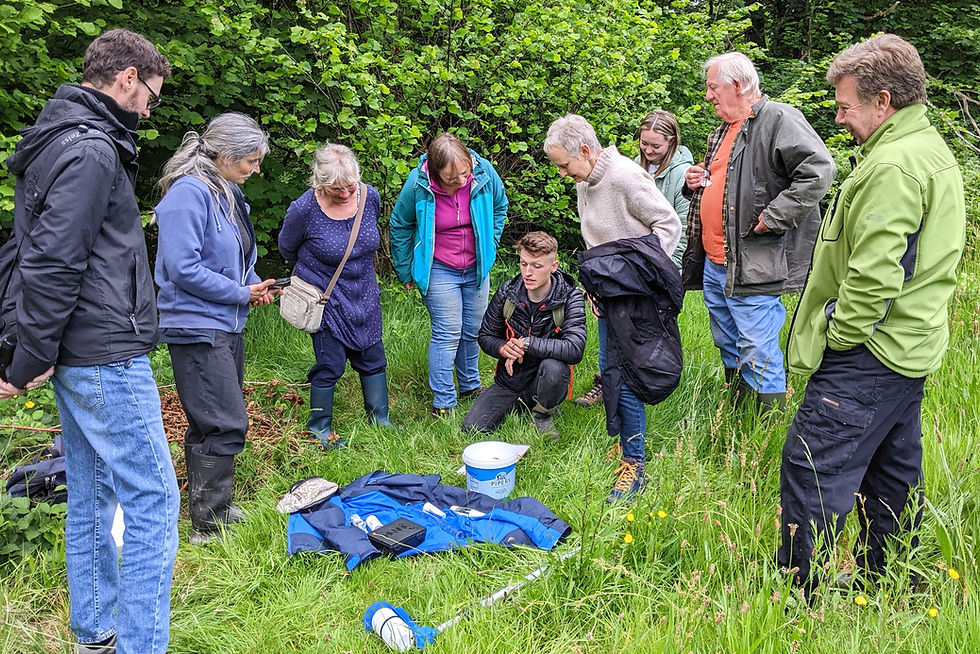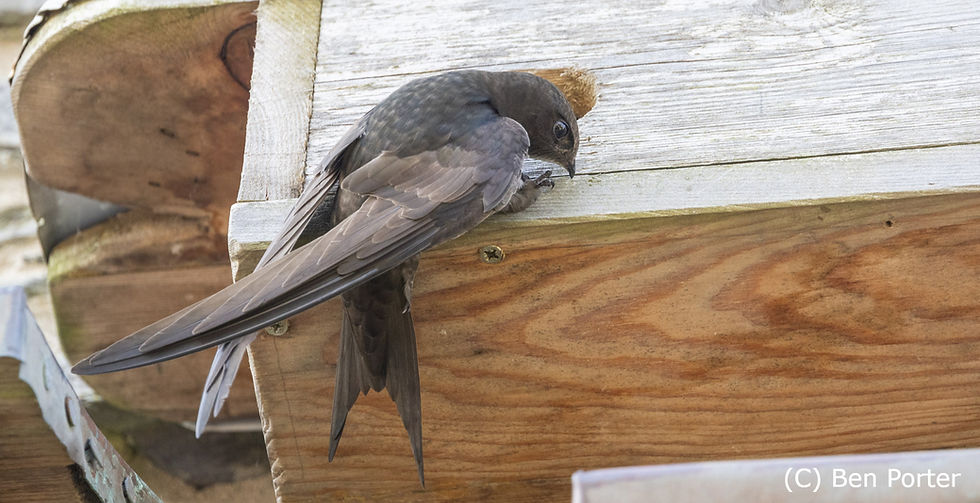Blog: Screams and Streams Project - Summer of swifts, rivers and community
- dyfibiosphere
- Sep 2
- 5 min read
Bryn Hall, coordinator on Screams & Streams reflects on the project which has just come to an end. Darllen yn Gymraeg.

Community-led Research
This summer community members from across the Dyfi Biosphere banded together to survey swifts and river health, as part of an exciting new community-led action research project funded by Cymru Wledig LPIP Rural Wales.
Community-led action research is where communities decide on and lead investigations in an area that they are concerned about. This type of research puts community at its heart and challenges the traditional ‘extractive’ methods where communities rarely see the results of their work; instead taking a ‘circular’ approach to leverage it for positive change, whether that be in changing policy, guiding future investments or encouraging behavioural change.
Swifts and Rivers?
At the start of the year the Dyfi Biosphere put out a call for applications and two keen community groups came back, the Dyfi Biosphere Swift Project and Lab Dŵr Dyffryn Dyfi.
The Dyfi Biosphere Swift Project was formed in 2021, bringing people together to help tackle the 76% decline of swifts in Wales over the past 30 years, whilst Lab Dŵr Dyffryn Dyfi was established in light of the growing concerns surrounding river health across the country.
These two groups decided to combine their shared interests to identify whether there was a clear link between river health and swift survival. In April 2025 they launched the ‘Screams & Streams’ project.
The key objectives were to empower local communities with the skills and equipment they needed, establishing a baseline dataset, monitoring change over time, and examining the link between swifts and river health.
“The common swift is a truly iconic and emblematic bird of a British summer, but it is in decline in Wales. …it has been an exciting and productive partnership involving volunteers from the local communities engaging as citizen scientists gathering data on water quality from water courses running into the main Dyfi river and conducting swift surveys.”
Elfyn Pugh - Dyfi Biosphere Swift Project
“Linking air and water - swifts and rivers adds another layer to our understanding that each one influences the other, it deepens our understanding of nature. However, there is also the personal and shared experiences of working together on a shared interest. With collective, informed and shared experience we strengthen ourselves individually and collectively. The project approach meant that people with little or no knowledge could become an involved and valued member of the team.”
Jenny Lampard - Lab Dŵr Dyffryn Dyfi
The Project
The project began by partnering with the Centre for Alternative Technology (CAT) to deliver water testing and swift surveying training to over 25 community members. Following this initial stage a range of volunteers were recruited as citizen scientists, establishing a network of over 45 community members. With cooperation from landowners across 10 different sites and partnership with organisations such as New Dovey Fisheries Association the project was underway.

Over 4 months volunteers surveyed swift breeding populations at each site, recording nesting activity and 'screaming parties' by utilising the Cofnod and SwiftMapper public data entry systems.
With specialist water testing kit acquired through the funding, volunteers sampled water for an hour at each site every two weeks along the Dyfi river and its main tributaries from Llanymawddwy near its source to Borth, testing for temperature, pH, nitrates and other chemical and physical characteristics. The teams also surveyed invertebrate life above and below the water's surface, via point counts and kick sampling. Kick sampling involved collecting and identifying macroinvertebrates that live on and in the riverbed, many of which will eventually emerge as flying insects. This is a key method for gauging the overall condition of a river’s health.

Key Findings
The team identified a total of 107 swift nests and 63 ‘screaming parties’ across the biosphere. The largest nesting populations are in Machynlleth and Ceinws, with 17 and 16 nests respectively. Llanymawddwy and Borth both recorded no nests.
A promising bit of news highlighted in the report is that swift boxes made up about 26% of the recorded nests, showing that boxes can be an effective alternative to natural nest sites for swifts, especially where there are no other options.
This research establishes a vital baseline of natural and artificial nest sites in the Biosphere, whilst highlighting how valuable and pivotal community input is in pinpointing nest numbers and locations. It can also be helpful in identifying where more nest boxes might be needed, all the swift boxes in Pennal for example are occupied, suggesting more installations might be valuable.
“As a result of the dedicated effort exerted by project volunteers through the spring and summer season of 2025, we have gained a better understanding of the swift breeding population in the Dyfi Valley. The valuable data collected and stored for posterity on the SwiftMapper and Cofnod ‘A Swift Recovery’ databases will form the basis for future conservation work in the Dyfi Valley to help our common swifts. This will probably involve seeking funding from various sources to acquire swift boxes to put up in our widely spread communities. This is truly the most effective way forward to help our declining swift population.”
Extract of comment from Elfyn Pugh - Dyfi Biosphere Swift Project

Water testing revealed that the Dyfi Biosphere’s rivers seem fairly healthy, but most notably the rivers are acidic. Further investigation showed that the catchment exhibits a great amount of soil acidification, especially in areas of coniferous forestry, which is likely impacting the rivers, although more testing would be valuable to understand this better.
Whilst heavy metal testing wasn’t done as part of this research, there are many abandoned metal mines throughout the region, there may be value in future testing. This is true especially as heavy metals often become more bioavailable in acidic conditions, and this could present problems for aquatic life.
Kick sampling results revealed a range of interesting life below the waters surface and highlighted a good range of pollution-sensitive species present in the rivers; however, some rivers still ranked poorly, possibly because of acidic conditions.

What next…
With an outstanding quality of community engagement this project, lasting just over 4 months, has played a key role in gathering data, whilst connecting community members to nature and to each other. Whilst a statistical relationship between common swift survival and river health is not possible to establish from the current data, further research may help to build clearer ecological links of significance between the two. We do however now have an important baseline dataset which we could use as a starting point for future research in the Dyfi Biosphere.
“Whilst Screams and Streams was a science based project it also has a very profound human side to it. We might not have otherwise connected with the people from our communities.”
Extract of comment from Jenny Lampard – Lab Dŵr Dyffryn Dyfi
Screams & Streams may be wrapped up now, but the Biosphere will still need help with future surveying. If you would like to be involved or learn more, get in touch.







Comments